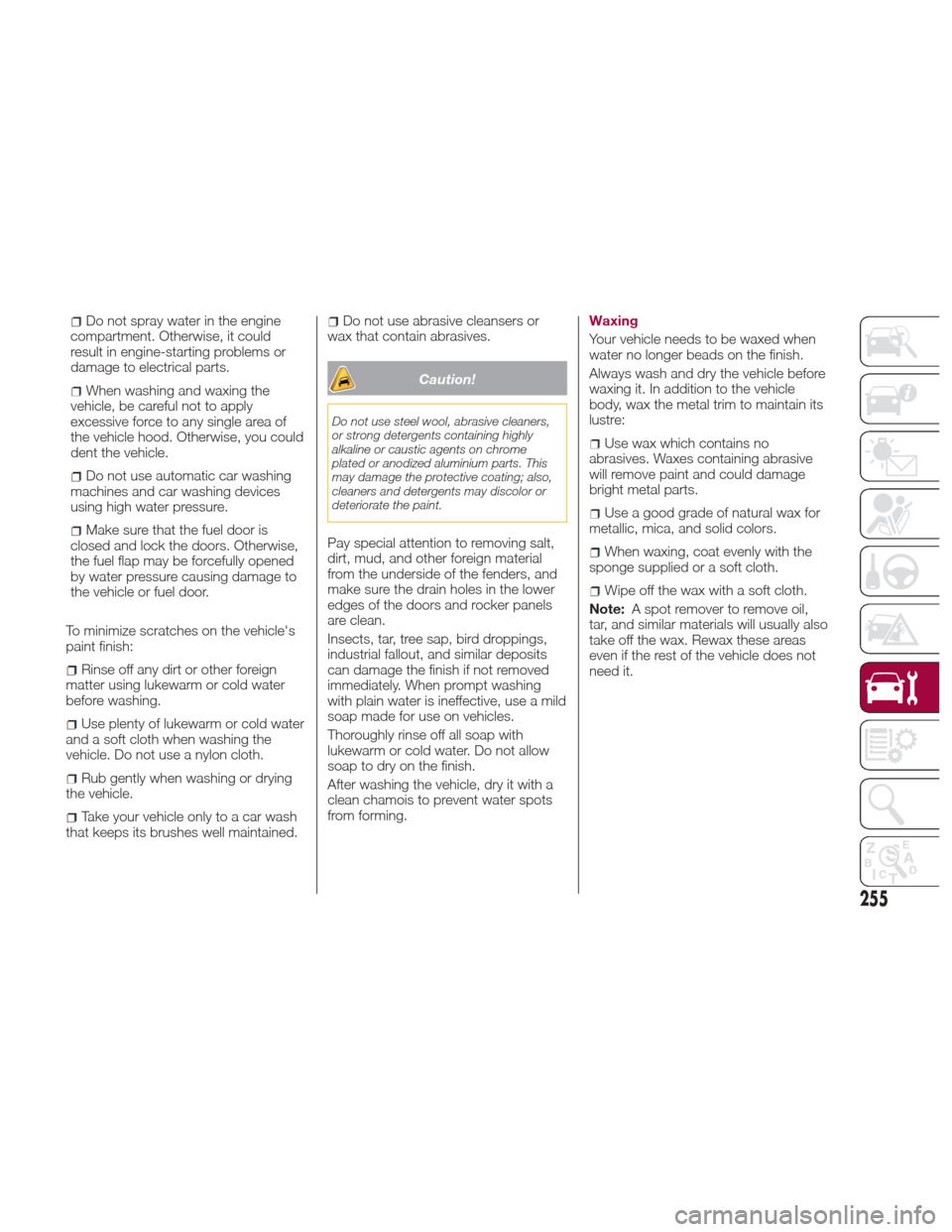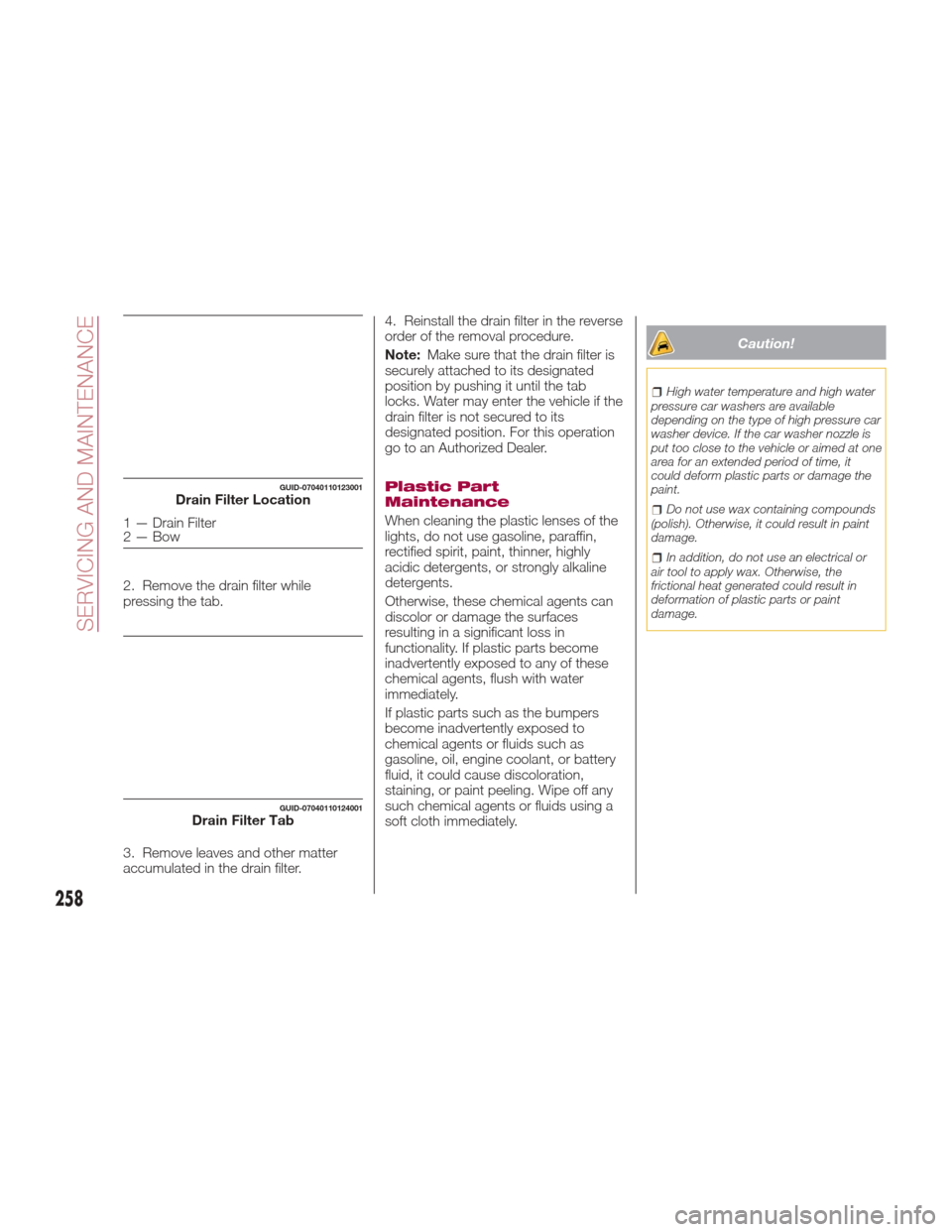2017 FIAT 124 SPIDER ABARTH engine oil
[x] Cancel search: engine oilPage 257 of 292

Do not spray water in the engine
compartment. Otherwise, it could
result in engine-starting problems or
damage to electrical parts.
When washing and waxing the
vehicle, be careful not to apply
excessive force to any single area of
the vehicle hood. Otherwise, you could
dent the vehicle.
Do not use automatic car washing
machines and car washing devices
using high water pressure.
Make sure that the fuel door is
closed and lock the doors. Otherwise,
the fuel flap may be forcefully opened
by water pressure causing damage to
the vehicle or fuel door.
To minimize scratches on the vehicle's
paint finish:
Rinse off any dirt or other foreign
matter using lukewarm or cold water
before washing.
Use plenty of lukewarm or cold water
and a soft cloth when washing the
vehicle. Do not use a nylon cloth.
Rub gently when washing or drying
the vehicle.
Take your vehicle only to a car wash
that keeps its brushes well maintained.
Do not use abrasive cleansers or
wax that contain abrasives.
Caution!
Do not use steel wool, abrasive cleaners,
or strong detergents containing highly
alkaline or caustic agents on chrome
plated or anodized aluminium parts. This
may damage the protective coating; also,
cleaners and detergents may discolor or
deteriorate the paint.
Pay special attention to removing salt,
dirt, mud, and other foreign material
from the underside of the fenders, and
make sure the drain holes in the lower
edges of the doors and rocker panels
are clean.
Insects, tar, tree sap, bird droppings,
industrial fallout, and similar deposits
can damage the finish if not removed
immediately. When prompt washing
with plain water is ineffective, use a mild
soap made for use on vehicles.
Thoroughly rinse off all soap with
lukewarm or cold water. Do not allow
soap to dry on the finish.
After washing the vehicle, dry it with a
clean chamois to prevent water spots
from forming. Waxing
Your vehicle needs to be waxed when
water no longer beads on the finish.
Always wash and dry the vehicle before
waxing it. In addition to the vehicle
body, wax the metal trim to maintain its
lustre:
Use wax which contains no
abrasives. Waxes containing abrasive
will remove paint and could damage
bright metal parts.
Use a good grade of natural wax for
metallic, mica, and solid colors.
When waxing, coat evenly with the
sponge supplied or a soft cloth.
Wipe off the wax with a soft cloth.
Note: A spot remover to remove oil,
tar, and similar materials will usually also
take off the wax. Rewax these areas
even if the rest of the vehicle does not
need it.
255
Page 260 of 292

2. Remove the drain filter while
pressing the tab.
3. Remove leaves and other matter
accumulated in the drain filter.4. Reinstall the drain filter in the reverse
order of the removal procedure.
Note:
Make sure that the drain filter is
securely attached to its designated
position by pushing it until the tab
locks. Water may enter the vehicle if the
drain filter is not secured to its
designated position. For this operation
go to an Authorized Dealer.
Plastic Part
Maintenance
When cleaning the plastic lenses of the
lights, do not use gasoline, paraffin,
rectified spirit, paint, thinner, highly
acidic detergents, or strongly alkaline
detergents.
Otherwise, these chemical agents can
discolor or damage the surfaces
resulting in a significant loss in
functionality. If plastic parts become
inadvertently exposed to any of these
chemical agents, flush with water
immediately.
If plastic parts such as the bumpers
become inadvertently exposed to
chemical agents or fluids such as
gasoline, oil, engine coolant, or battery
fluid, it could cause discoloration,
staining, or paint peeling. Wipe off any
such chemical agents or fluids using a
soft cloth immediately.
Caution!
High water temperature and high water
pressure car washers are available
depending on the type of high pressure car
washer device. If the car washer nozzle is
put too close to the vehicle or aimed at one
area for an extended period of time, it
could deform plastic parts or damage the
paint.
Do not use wax containing compounds
(polish). Otherwise, it could result in paint
damage.
In addition, do not use an electrical or
air tool to apply wax. Otherwise, the
frictional heat generated could result in
deformation of plastic parts or paint
damage.
GUID-07040110123001Drain Filter Location
1 — Drain Filter
2 — Bow
GUID-07040110124001Drain Filter Tab
258
SERVICING AND MAINTENANCE
Page 275 of 292

FLUID CAPACITIES
ItemCapacities
Fuel tank 11.9
(gallons) / 45 (liters)
Engine oil (without oil filter replacement) 3.3 (quarts) / 3.2 (liters)
Engine oil (with oil filter replacement) 4.0 (quarts) / 3.8 (liters)
Coolant (with manual transmission) 7.6 (quarts) / 7.2 (liters)
Coolant (with automatic transmission) 7.5 (quarts) / 7.1 (liters)
Manual transmission oil 2.2 (quarts) / 2.1 (liters)
Automatic transmission fluid 7.8 (quarts) / 7.5 (liters)
Rear differential oil 0.63 (quarts) / 0.6 (liters)
LSD oil 0.63 (quarts) / 0.6 (liters)
Brake fluid (& clutch fluid) 0.57 (quarts) / 0.55 (liters)
273
Page 276 of 292

FLUIDS AND LUBRICANTS
Fluids And Lubricants
Your vehicle is equipped with an engine oil that has been thoroughly developed and tested in order to meet the requirements of
the Scheduled Servicing Plan.
Constant use of the prescribed lubricants guarantees the fuel consumption and emission specifications. Lubricant quality is
crucial for engine operation and duration.
LubricantCharacteristics SpecificationReplacement interval
Engine oil W
e recommend you use API
Certified SAE 5W-40 Full
Synthetic Engine Oil, meeting the requirements of FCA Material
Standard MS-12991. Refer to your engine oil filler cap for correct SAE grade. According to Scheduled
Servicing Plan
Coolant Mopar Long Life Coolant
Concentrate for FIAT Spider According to Scheduled
Servicing Plan
Manual transmission oil MOPAR Manual Transmission
Long Life Gear Oil for FIAT Spider
Automatic transmission fluid MOPAR Automatic Transmission
Long Life Fluid for FIAT Spider
Rear differential oil MOPAR Long Life Hypoid Gear
Oil for FIAT Spider
Limited slip differential oil Mopar Long Life Limited Slip
Additive for FIAT Spider
Brake/Clutch fluid We recommend you use MOPAR
DOT 3. If DOT 3 brake fluid is not available, then DOT 4 is acceptable.
If lubricants compliant with the required specifications are not available, products that comply with the minimum required
characteristics can be used for topping up; in this case optimal performance of the engine is not guaranteed.
274
TECHNICAL SPECIFICATIONS
Page 287 of 292

Electronic Vehicle Information
Center (EVIC) Setup Menu.....78
EVIC Display ..............78
Emergency flap opening ........174
Emergency Key ..............19
Emergency, In Case Of .........207
Hazard Warning Flasher ......183
Jacking ..........202,203,237
Jump Starting ............217
Overheating .............219
Towing ............. .220,221
Emission control system .........75
Engine .................. .266
Exhaust Gas Caution ........173
Fails To Start .............218
Flooded, Starting ..........218
Jump Starting ............217
Overheating .............219
Starting ..............21,218
Engine compartment ..........230
Engine coolant (level check) ......231
Engine oil (level check) .........231
Environment protection systems ....75
Essential information ............3
Ethanol .................. .172
Event Data Recorder ..........145
Exhaust Gas Caution ..........173
Exterior Lights ...............38Flash-To-Pass...............40
Flashers Hazard Warning ...........183
Turn Signal ...............41
Flooded Engine Starting ........218
Fluid And Lubricants ..........274
Fluid Capacities .............273
Fog Lights ..................41
Follow Me Home .............41
Front lights (light bulbs) .........186
Front Wipers Wiper Operation ...........42
Fuel Additives ...............173
Clean Air ...............172
Ethanol ............... .172
Materials Added ...........173
Methanol ...............172
Fuel Consumption Display ........88
Fuel Economy Monitor ..........87
Fuel filler cap ...............174
Fuel filler door ...............173
Fuse block (engine compartment) . .196
Fuse block (interior) ...........200
Fuses (interior) ..............194
Fuses (underhood) ............195
Gasoline, Clean Air...........172
Gasoline, Reformulated ........172Gear selector positions
.........153
GVWR .................. .175
Hazard Warning Flasher........183
Hazardous driving ............177
Head Restraints ............34,35
Headlight ..................38
Headlights Adjusting The Headlight
Abroad..................42
High Beam ...............40
Passing .................40
Heavy-duty use of the vehicle (scheduled servicing) ........224
HomeLink (Garage Door Opener) ........59
Hood Release ...............69
How to use this manual ..........3
Identification Data............263
Inside Rearview Mirror ..........36
Instrument Cluster Display DID Menu Items . . . .79,80,82,83,84
EVIC Menu Items . . .79,80,82,83,84
Interior Lights ................63
Interiors ................. .259
Internal Equipment ............61
Jack Location..............202
Jack Operation ........202,203,237
Jump Starting ...............217